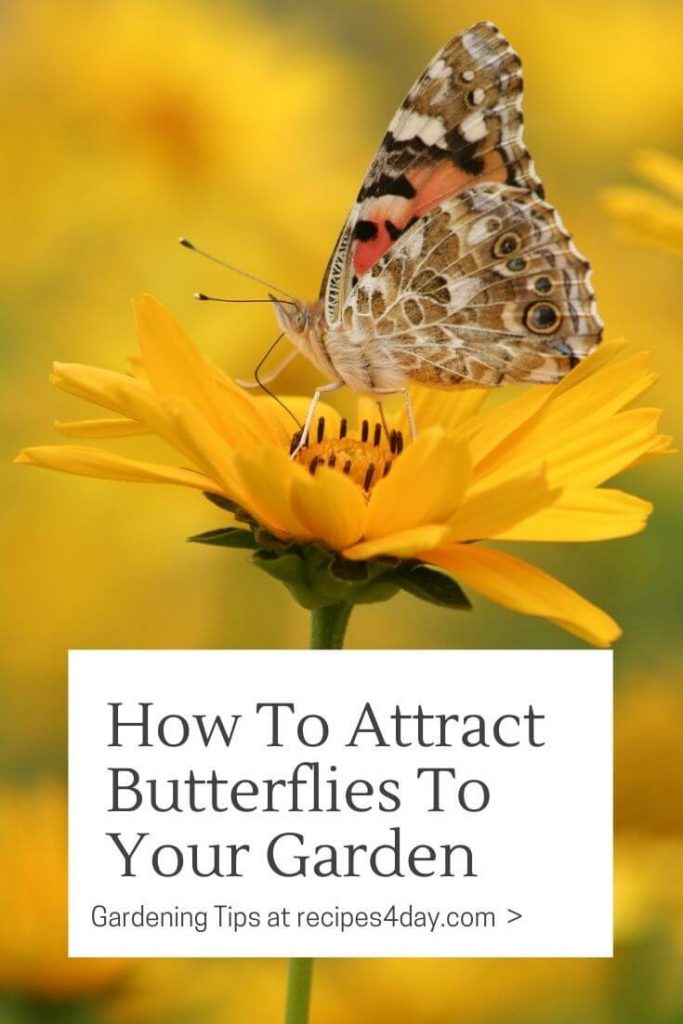You Must Create The Habitat If You Want To Attract Butterflies To Your Garden! They will seek you out once you have created the resources.
Butterflies may not come when you want them to or right away BUT sooner or later they will come. Have patience!
Let’s learn how to create what butterflies need from you in order for you to enjoy watching them.
You have some questions to ask yourself and then find out the answer before you start to attract butterflies to your garden.
- What butterflies are native to my area?
- What plants are used by butterflies in all stages of their life.
- What do they use to lay eggs and what food do they need?
- What plants provide nectar to adult butterflies?
A lot of readers have asked specifically about attracting Monarch Butterflies. We will look at them along with other species.
The fun stuff is planting a Butterfly flower garden. For people, like you and me, who are interested in Monarchs and other species, a butterfly garden is a real easy way to see more monarchs in your backyard and also to contribute towards their conservation.
If you plant a butterfly garden with all their needs, you will not only have Monarchs in your yard BUT many other butterfly species along with them in your backyard.A butterfly gardener will reap many rewards from your butterfly garden project. People normally enjoy colorful flowers that butterflies prefer, so a butterfly garden is a win win garden. The butterflies love you and you and your neighbors or passer-byes get to enjoy the beauty as well.
Butterflies LOVE lots of different plants, so when creating your garden make sure to add diversity and make sure to have bloom times all season long! Diversity can reduce populations of pest insects (we know all about those, right?) by diversifying you are making it harder for those pests to find their host plants. Butterflies also like native plants which means less maintenance for you since those plants are used to the weather in your area!
Your butterfly garden can be any size. Make sure to plan it out before you begin outside. Draw it on paper and write down the plants that you want in your backyard for this section of your garden. You can also choose to include window boxes in your plan.
TIP: I recommend a journal just for your butterfly project(s). Don’t forget, Make sure to include some native plants.
TIP: Be sure to pick plants that bloom at different times of the season and place them strategically throughout your garden.
BONUS! Butterflies are a very important piece to our ecosystem, and can pollinate many plants.
Butterflies are very easy to watch because they are active during the warmest parts of the day. This is usually when we are out-and-about as well. They also have many interesting behaviors, have you noticed? For instance, after it rains, you might see them “puddling,” or sucking some fluid from wet soil to obtain water and salts.
On cool sunny mornings, you may find a butterfly basking in the sun on a rock to warm-up their muscles for a power flight. You can supply them with a stone of any kind. Garden stones are nice. They are perfect for garden decor and great for the butterflies that choose to land on them.
The females often have elaborate routines (can you relate? How is your routine in the morning or during the day?) they must choose where to lay their eggs wisely; such a big decision.
Male butterflies are interesting. They are mostly territorial. They will chase other males away and try to attract females.
If you want some entertainment and love God’s creation, sit with a pair of binoculars, a field guide, a variety of flowers in bloom that butterflies love. On a sunny calm day, you can sit in your yard and will be able to identify many different butterfly species. If you find that you are missing that one species you really want to see, next year include its favorite plant in your garden.
To get the most out of your Butterfly garden, make sure you include both caterpillar food plants and butterfly nectaring plants. You really need ALL the pieces to get your fill of the butterfly world. By having both plants in your garden you will find that the butterflies are more than likely to linger and explore possible sites in your yard to lay their eggs.
It will also increase your chances 10-fold of observing both mating and egg-laying behaviors, as well as the complete butterfly life cycle from egg to adult. FUN! Don’t worry, I am not talking about the caterpillar moths that kill your garden plants.
REMEMBER: DO NOT USE ANY PESTICIDES OR INSECTICIDES These will KILL your butterflies too!

